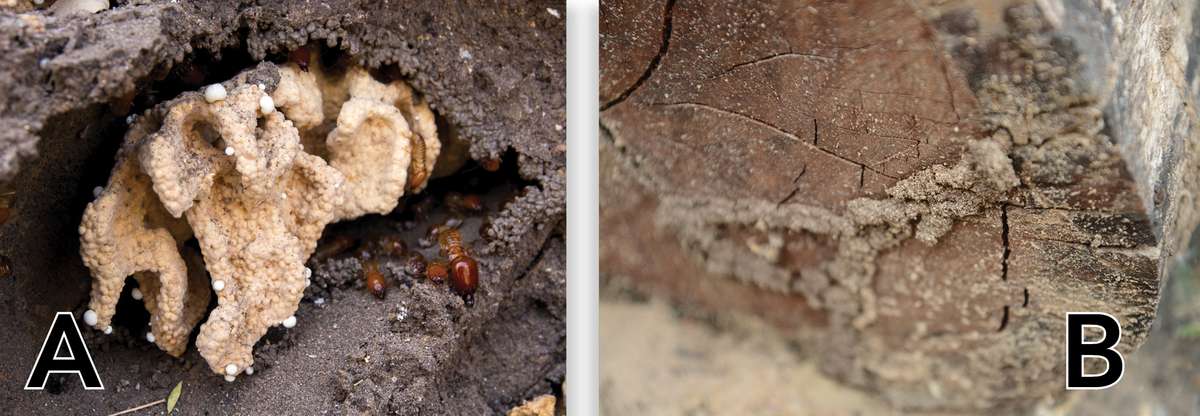Tithonia is known for its high nitrogen content, palatability as a livestock forage, and rapid growth throughout the tropics and subtropics. Network member Tim Tanner has also experimented with using it, as well as neem, to control termites (Figure 8) before planting trees.

Figure 8. Inside of termite colony (A) and termite activity (B). Source: Noah Elhardt (A) and Jason Weigner (B).
Methods
At first, I was not covering the tithonia-only fermented liquid. I would stuff as much tithonia biomass as I could in a bucket by stomping on it, pounding on it, whatever it took to really stuff it [full]. I would add water just enough to make sure the top layer was covered in water. I left the bucket open. It would decompose totally with just a few stringy stems left within five days normally.
It stunk and I was doing [this] just next to our homeschool classroom. So, I started covering the buckets with a lid. But [by] about day four or five the lid would burst off if it was on too tight.
Application
I was primarily using it as a termite prevention around my saplings. I had to make sure to leave a good 6-inch [15-cm] diameter from the stem/stock as my solution was strong, but again, I was going for termite protection, not necessarily fertilizer.
I would get anywhere from four to six weeks of good termite protection. If it rained, that seemed to weaken and dilute the protection somewhat.
But it did really help me establish saplings and other plants. I presume it was also helping with nitrogen and phosphorus additions [to the soil].
Cautions and adaptations
Since I was normally going for termite protection, I did not dilute [the fermented liquid]. But I found if I poured it too close to the sapling it would burn the sapling. Thus, my thought would be [if you] use it as a fertilizer you would have to dilute it in order to put it directly on a plant. Play with the ratio and try [it in a small area of your field/garden].
At Kilimo Timilifu we have no tithonia. But we have played around some with neem (Azadirachta indica) leaf [fermented liquid or] “tea” made the same way (though it takes a bit longer to decompose) and have had some undocumented success. We have had quite a problem with establishing saplings due to termites. So, we dig the hole and line the hole with ash. Then transplant the sapling into the hole. Then, we pour the neem tea around the sapling. The neem tea makes a shaft of protection and meets up with the ash at the bottom of the hole which is preventing termites from coming up from underneath.